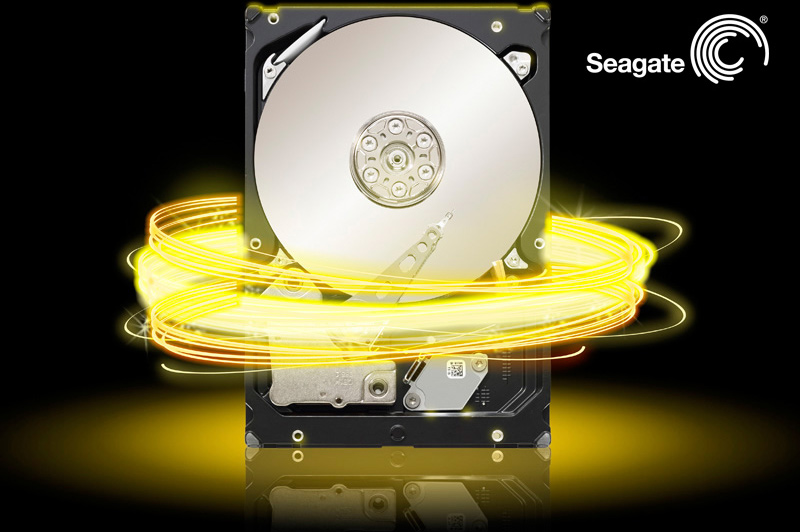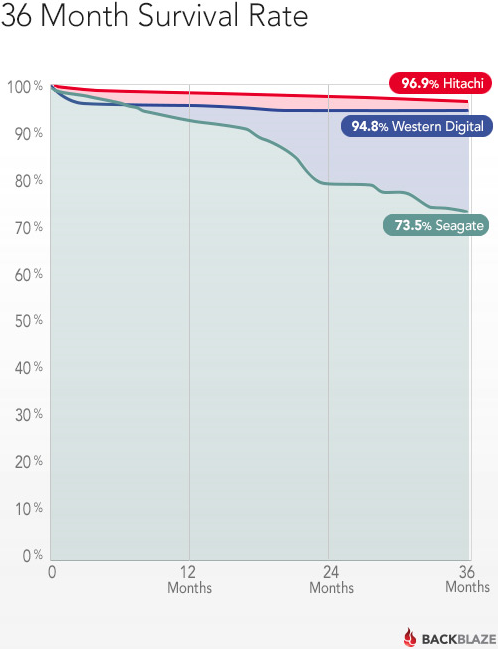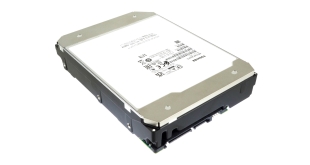Seagate Technology has issued a statement regarding consumer hard drive reliability report published by Backblaze. The company claims that the data published by the cloud-storage provider, which uses consumer-class HDDs and extensive replication mechanisms to store data for its clients, contradicts reliability reports by other customers. Moreover, Seagate notes that its desktop drives are not designed for cloud datacentre environments.
“We always value our customers’ feedback and take it very seriously,” a statement by Seagate reads. “It appears that Backblaze is reporting data from the same sample of drives from last year, which continues to be inconsistent with data received from other customers, and our large OEM installed base.”
According to Backblaze, Seagate’s Barracuda hard disk drives are considerably less reliable than competing products from HGST and Western Digital on annual failure rate basis. Moreover, their 36-month survival rate is also dramatically lower than that of other HDDs. Backblaze claims that the Seagate drives die off at a consistently higher rate, with a burst of deaths near the 20-month mark.
What is noteworthy is that despite of the fact that Backblaze uses Seagate’s HDDs in environments they were not designed for, the manufacturer still respects its warranty and replaces the drives. Still, given the fact that the Barracuda belongs to the consumer family of products, Seagate does not replace the failed HDDs with new ones (like in the case of enterprise drives), but ships reconditioned hard drives instead.
“We absolutely stand behind the quality of our products with a best-in-class warranty, and we relentlessly test our drives for the workloads they were designed to support,” the statement claims. “We highly recommend that our enterprise and data center customers use the appropriate class of product to handle the workloads of enterprise environments.”
Backblaze complained that certain hard drives from Seagate and Western Digital, which are designed to be energy-efficient, in the cloud data environments spin down and up very frequently, which theoretically causes a lot of wear out. In addition, vibrations in server racks also have impact on their lifespan.
“As with previous data reported by Backblaze, desktop-class drives and some external drives were purchased and used in enterprise-class workloads – which they were not designed for nor tested to support,” Seagate said.
Discuss on our Facebook page, HERE.
KitGuru Says: Contemporary hardware for different use cases is designed differently and is made using different process technologies. While it is nice to have extreme performance and extreme reliability, the majority of consumers demand maximum amount of storage, rapid read speeds and quiet operation at the lowest possible price, which is why, for example, there are no 10K or 15K HDDs optimized for concurrent read and write operations aimed at home users. The same applies to cloud datacentre environments: the drives may not offer absolutely highest performance and capacities, but they are developed with vibrating RAID environments and other datacentre-specific things in mind. Therefore, for the best results, it makes a lot of sense to utilize HDDs that were optimized for particular usage scenarios.
 KitGuru KitGuru.net – Tech News | Hardware News | Hardware Reviews | IOS | Mobile | Gaming | Graphics Cards
KitGuru KitGuru.net – Tech News | Hardware News | Hardware Reviews | IOS | Mobile | Gaming | Graphics Cards





It’s still fairly damning, Seagate. If Hitachi can issue desktop-class HDD’s that stand up so well in a server environment, you have no excuse.
This may be true, but you also pay for what you get. I won’t claim to know most corners of the internet, but in general I can find Seagate Barracuda drives for a good deal less than I can find HGST Travelstars etc. I personally enjoy my HGST though.
Seagate have a really poor build quality, on my old barracuda the sata connection snapped off whilst it was in the case, there was nothing putting even a slight amount of pressure on it and the best part is they don’t cover it in their warranty
not regarding these companies but don’t use Toshiba, have a really bad experience with them!!
Yeah I’ve got two 3TB barracudas, running well in my PC, but the numbers are here. Even if this place was abusing the drives, the competition had the same abuse and stood up well.
That was my point about price though. If the tech making it is the same, I don’t understand why people expect the cheapest consumer product to last as long as the more expensive competition. It’s simple. I’m not exactly defending them; I’m just saying you pay for what you get.
It’s like buying a $60 phone then complaining that it doesn’t last as long as an $80 phone with the same features from a different (or even the same) manufacturer.
“Seagate notes that its desktop drives are not designed for cloud datacentre environments.”
The same is true for WD and Hitachi and yet, THEY have a 21% better survival rate = they are of much better quality. What is it exactly you don’t understand in that statement, Seagate?
http://www.theregister.co.uk/2014/02/17/backblaze_how_not_to_evaluate_disk_reliability/
not sure who’s right, but I remember this from an earlier Backblaze report, and thought I’d link it in the interests of fairness.
Backblaze are idiots… they’re wasting more money on consumer grade drives than if they were to invest in some PROPER datacenter grade disks… there’s a slew of different drives from all manufacturers that ARE designed for the stressful 24-7 datacenter environment… just to name a few:
WD RED NAS (all capacities)
WD Velociraptor
Seagate Constellation ES
Seagate cheetah
HGST Helio line
and if I recall, Hitachi also has enterprise class drives… I just can’t remember any product strings!
all of these in the long run will provide greatly increased reliability and stability than the desktop class drives being used. and Backblaze would save shedloads on the maintenance of the racks as well… therefore then being able to possibly reduce the end user’s costs and rake more clients in!… there’s a bit of a chain here that if they listened to the manufacturers… they would be in with some more immense profits and even better reliability than ever!
it serioulsy depends… Seagate’s Constellation ES drives thrash the heck out of those hitachi drives over the MBF period… it’s how the disk controllers are built and the manufacturing process used on the hard disk RW heads and platters as well as the quality of all the bearings and motors driving the unit… on Seagate’s Barracuda drives, they’re designed for the best bang for the buck in terms of capacity whilst delivering reasonable reliability. I’ve run Seagate drives for a long time alongside Western Digital, and on a 4-7 workload, the Seagate drives have lasted an average of 5 years, pretty much equalling the WD drives I’ve used (all WD3200AAJS 320GB if you wanna know) with the odd anomalous failure put down to a defect and immediately replaced from both WD and Seagate… still… nothing beats my old Maxtor DiamondMax for reliability… 11 years old and not a single bad sector or read error!
And WD can stand so well in that 24/7 server environment as well.
Damn Seagate, fix your shit.
People seem to be completely glossing over the “energy saving” features present in Seagate desktop drives. These drives are built and designed to spin down whenever they’re not in use in order to lower power consumption. On the other hand, WD/HGST drives’ internal controllers keep them spinning constantly, and they’re only ever spun down when the system they’re installed in tells them to. On the enterprise side of things, where Seagate drives also let the system control power flow, they last for an eternity. I work in a data center, and well over 90% of the drives we use are Seagates. In the time I’ve worked here (18 months), I’ve replaced 15 failed drives. Considering we have 535 racks with an average of 360 drives each (we average 10 2U24 and 10 2U12 enclosures per rack for a rough total of 192,600 total drives), that’s an extremely good failure rate.
Toshiba drives are made by HGST…
Necro, but connections don’t just snap off by themselves. I always get a kick out of clients that make statements like this at my job.